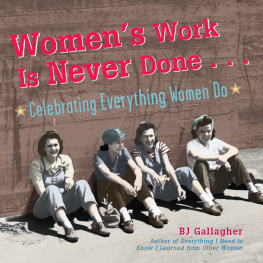First published 1992 by Westview Press
Published 2019 by Routledge
52 Vanderbilt Avenue, New York, NY 10017
2 Park Square, Milton Park, Abingdon, Oxon OX14 4RN
Routledge is an imprint of the Taylor & Francis Group, an informa business
Copyright 1992 by Taylor & Francis
All rights reserved. No part of this book may be reprinted or reproduced or utilised in any form or by any electronic, mechanical, or other means, now known or hereafter invented, including photocopying and recording, or in any information storage or retrieval system, without permission in writing from the publishers.
Notice:
Product or corporate names may be trademarks or registered trademarks, and are used only for identification and explanation without intent to infringe.
Library of Congress Cataloging-in-Publication Data
Women's work and women's lives: the continuing struggle worldwide /
edited by Hilda Kahne and Janet Z. Giele.
p. cm.
Includes bibliographical references and index.
ISBN 0-8133-0636-1
1. Equal pay for equal work. 2. WomenEmployment. 3. WomenEconomic
conditions. 4. WomenSocial conditions. I. Kahne,
Hilda. II. Giele, Janet Zollinger.
HD6061.W64 1992
331.4-dc20 92-12157
CIP
ISBN 13: 978-0-367-21392-3 (hbk)
This book about the changing lives of women around the world was conceived in winter 1987-1988 at a time when neither of the editors could have imagined the momentous events of the next five years. Who would have predicted the Tiananmen Square repression of 1989 in China, the democratic revolutions in Eastern Europe during the same year, the dismantling of apartheid in South Africa in 1990, or the August coup that resulted in toppling the Soviet Communist Party in 1991? Our global society, marked not only by change but also by growing interdependence, throws into sharp relief the similarities and differences among nations as well as in the lives of the individual women and men who inhabit them.
For Hilda Kahne, who was a Wheaton College faculty member in Kenya in summer 1985, the idea for this book was sparked by attendance at the Nairobi Conference that concluded the UN Decade for Women (1976-1985), The deep sense of sisterhood that prevailed at the conference, even across national boundaries, led to a consideration of the common elements in women's experience and mutual support. One wanted to understand more fully the distinct nature of women's place in society that produced a sense of connectedness despite major differences in geographic location, levels of economic development, political structures, cultural and religious traditions, and personal lives.
For Janet Z. Giele, many of the same issues had arisen in an earlier book, Women: Roles and Status in Eight Countries, which appeared in 1977. At that time a central question involved the relative status of women: Why did women experience near equality with men in some countries, whereas in other countries their life options were severely limited? An obvious sequel was to consider how women's roles and status had changed by the last decade of the twentieth century.
The present book thus grew out of both of our interests in understanding women's changing roles around the globe. To provide a baseline for comparison, we agreed that a primary focus of the book should be women's paid work. Then, as each contributor's interests and expertise dictated, the country chapters also could sketch a larger picture of women's lives, showing the relationship of paid work to education, family life, and the larger social, economic, and political contexts.
In getting started, our challenge was to select a group of countries and regions to be included and to locate top-ranking social scientists whose work focused on these areas and coincided with our research interests. Although not all desired countries could be included for study, the book that emerged provides a wide range of descriptive detail on a variety of countries and regions around the globe. In addition, the resulting content gives a basis for comparison among developing regions, nations of the former Communist bloc, and Eastern and Western industrial democracies.
We are pleased that a number of disciplines are represented among the contributors of the country and regional studies: an anthropologist (Safa), two economists (Rudolph and Weil), a historian (Ohta), two political scientists (Lapidus and Wolchik), two psychologists (Kauppinen and Pleck), three sociologists (Cordilia, Haavio-Mannila, and Moghadam), and a British Labour Party research officer (MacLennan) working on policies for social protection and equal opportunity. Although these specialties are not reflected in the organizational structure of the book, the variety of the contributors' backgrounds and training is both a characteristic and a strength of the contemporary study of women's lives. In addition, half of these twelve authors currently live and work in countries other than the United States.
To set the stage for examining women's situation in each country, the two opening chapters consider the fundamental similarities across nations in the general factors that influence women's work roles and general status. Coeditor Janet Z. Giele, a sociologist, introduces the book with a critical review of the modernization theories that, until recently, predicted a gradual improvement of women's status with economic development. She develops a revised conceptual framework that gives a larger place to noneconomic factors such as religion and culture, race and class, and women's access to power. She then shows how women's situation is related to the structure of the state, the economy, and family life.
Economists Francine D. Blau and Marianne A. Ferber provide a broad overview of women's economic status in all parts of the world. Using quantitative data on labor force participation, occupational distribution, earnings, education, and time allocated to housework, they provide a sound basis for the international comparison of women's economic position relative to that of men. Nowhere have women achieved full equality with men. But in the advanced industrial nations, there is .some evidence of declining gender difference in job distribution and pay.
At the heart of the book are the ten chapters on women's work and lives in ten different regions or countries of the world. Brief summaries introduce each of the three sections on modernizing, socialist transitional, and advanced industrial societies.
In the book's concluding chapter, coeditor and economist Hilda Kahne returns to the key questions that launched the book. She finds several common features in women's roles and status around the world. Women everywhere share the experience of occupational segregation, pay inequity, and the double burden. These conditions are explained by economic structure, state policy, and traditions and social policies governing women's work and gender relations. Yet women's situation also varies because of market arrangements or distinctive religious or cultural traditions. In addition, social, economic, and political influences can alter the larger context that surrounds women's lives. Kahne concludes on a cautiously optimistic note by listing such positive trends as rising labor market experience and better working conditions and more education and training, all of which can improve women's position. In the end, however, a strong combination of international agencies, national and state governments, private-sector initiatives, and grass-roots community organizations will be needed to achieve greater equality for women at work and more support for their contributions to the home.







